Bioanalytical Assay Development and Validation for the Pharmacokinetic Study of GMC1, a Novel FKBP52 Co-chaperone Inhibitor for Castration Resistant Prostate Cancer
Abstract
:1. Introduction
2. Results and Discussion
2.1. Chromatography and MS Conditions
2.2. Method Validation
2.2.1. Specificity and Selectivity
2.2.2. Sensitivity and Linearity
2.2.3. Precision, Accuracy and Dilution Integrity
2.2.4. Extraction Recovery
2.2.5. Matrix Effect
2.2.6. Analyte Stability
2.3. Pharmacokinetic Study
3. Materials and Methods
3.1. Materials
3.2. Instruments and Conditions
3.3. Preparation of Standard and Quality Control Samples
3.4. Sample Preparation
3.5. Method Validation
3.5.1. Specificity and Selectivity
3.5.2. Sensitivity and Linearity
3.5.3. Precision, Accuracy and Dilution Integrity
3.5.4. Extraction Recovery
3.5.5. Matrix Effect
3.5.6. Analyte Stability
3.6. Pharmacokinetic Study
3.7. Pharmacokinetic Analysis
4. Conclusions
5. Patents
Author Contributions
Funding
Conflicts of Interest
References
- Heinlein, C.A.; Chang, C. Androgen Receptor in Prostate Cancer. Endocr. Rev. 2004, 25, 276–308. [Google Scholar] [CrossRef] [PubMed] [Green Version]
- De Leon, J.T.; Iwai, A.; Feau, C.; Garcia, Y.; Balsiger, H.A.; Storer, C.L.; Suro, R.M.; Garza, K.M.; Lee, S.; Kim, Y.S.; et al. Targeting the regulation of androgen receptor signaling by the heat shock protein 90 cochaperone FKBP52 in prostate cancer cells. Proc. Natl. Acad. Sci. USA 2011, 108, 11878–11883. [Google Scholar] [CrossRef] [PubMed] [Green Version]
- Yeh, S.; Niu, Y.; Miyamoto, H.; Chang, T.; Chang, C. Differential Roles of Androgen Receptor in Prostate Development and Cancer Progression. In Androgen Action in Prostate Cancer; Tindall, D., Mohler, J., Eds.; Springer Science & Business Media: Berlin, Germany, 2009; pp. 73–89. [Google Scholar]
- Tran, C.; Ouk, S.; Clegg, N.J.; Chen, Y.; Watson, P.A.; Arora, V.; Wongvipat, J.; Smith-Jones, P.M.; Yoo, D.; Kwon, A.; et al. Development of a second-generation antiandrogen for treatment of advanced prostate cancer. Science 2009, 324, 787–790. [Google Scholar] [CrossRef] [PubMed] [Green Version]
- Kobayashi, T.; Inoue, T.; Kamba, T.; Ogawa, O. Experimental Evidence of Persistent Androgen-Receptor-Dependency in Castration-Resistant Prostate Cancer. Int. J. Mol. Sci. 2013, 14, 15615–15635. [Google Scholar] [CrossRef] [PubMed] [Green Version]
- Decker, K.F.; Zheng, D.; He, Y.; Bowman, T.; Edwards, J.R.; Jia, L. Persistent androgen receptor-mediated transcription in castration-resistant prostate cancer under androgen-deprived conditions. Nucleic Acids Res. 2012, 40, 10765–10779. [Google Scholar] [CrossRef] [PubMed]
- Scher, H.I.; Sawyers, C.L. Biology of progressive, castration-resistant prostate cancer: Directed therapies targeting the androgen-receptor signaling axis. J. Clin. Oncol. 2005, 23, 8253–8261. [Google Scholar] [CrossRef] [PubMed]
- Cheung-Flynn, J.; Prapapanich, V.; Cox, M.B.; Riggs, D.L.; Suarez-Quian, C.; Smith, D.F. Physiological role for the cochaperone FKBP52 in androgen receptor signaling. Mol. Endocrinol. 2005, 19, 1654–1666. [Google Scholar] [PubMed] [Green Version]
- Storer Samaniego, C.; Suh, C.J.H.; Arundhati, C.; Karen, O.; Naihsuan, G.; Jeffrey, C.S.; Prasenjit, D.; Yumoto, F.; Fletterick, R.J.; Strom, A.M.; et al. The FKBP52 Cochaperone Acts in Synergy with beta-Catenin to Potentiate Androgen Receptor Signaling. PLoS ONE 2015, 10, e0134015. [Google Scholar] [CrossRef] [PubMed]
- Azad, A.A.; Zoubeidi, A.; Gleave, M.; Chi, K.N. Targeting heat shock proteins in metastatic castration-resistant prostate cancer. Nat. Rev. Urol. 2015, 12, 26–36. [Google Scholar] [CrossRef] [PubMed]
- Cox, M.; Skouta, R.; Cherkasov, A. Pharmaceutical Compositions Directly Targeting FKBP52 for the Treatment of Prostate Cancer and Methods of Using Same. U.S. Patent 010322113B2, 17 August 2017. [Google Scholar]
- Guy, N.C.; Garcia, Y.A.; Cox, M.B. Therapeutic Targeting of the FKBP52 Co-Chaperone in Steroid Hormone Receptor-Regulated Physiology and Disease. Curr. Mol. Pharmacol. 2015, 9, 109–125. [Google Scholar] [CrossRef] [PubMed]
- Neckers, L.M.; Cox, M.B.; Neckers, J.B.; Kim, Y.S.; Iwai, A.; Yangmin Ning, Y.; Kugelman-Tonos, J.; Balsiger, H.A.; Fletterick, R. Pharmaceutical Compositions Which Inhibit FKBP52-Mediated Regulation of Androgen Receptor Function and Methods of Using Same. U.S. Patent 20120283215A1, 4 March 2020. [Google Scholar]
- Liang, S.; Bian, X.; Liang, N.; Sivils, J.C.; Neckers, L.M.; Cox, M.B.; Xie, H. Solution formulation development and efficacy of MJC13 in a preclinical model of castration-resistant prostate cancer. Pharm. Dev. Technol. 2016, 21, 121–126. [Google Scholar] [CrossRef] [PubMed] [Green Version]
- Liang, S.; Bian, X.; Sivils, J.; Neckers, L.M.; Cox, M.B.; Xie, H. Quantification of a New Anti-Cancer Molecule MJC13 Using a Rapid, Sensitive, and Reliable Liquid Chromatography-Tandem Mass Spectrometry Method. Am. J. Mod. Chromatogr. 2014, 1, 1–11. [Google Scholar] [PubMed]
- Cox, M.; Xie, H.; Ekpenyong, O. Intravenous Formulation and LC/MS/MS Analysis Method for GMC1. U.S. Patent 10,010,534, 3 July 2018. [Google Scholar]
- United States Food and Drug Administration. Guidance for Industry—Bioanalytical Method Validation. Center for Drug Evaluation and Center for Drug Evaluation and Research and Center for Veterinary Medicine, Editors. 2018. Available online: http://www.fda.gov/cder/guidance (accessed on 28 May 2019).
- Matuszewski, B.K.; Constanzer, M.L.; Chavez-Eng, C.M. Strategies for the Assessment of Matrix Effect in Quantitative Bioanalytical Methods Based on HPLC-MS/MS. Anal. Chem. 2003, 75, 3019–3030. [Google Scholar] [CrossRef] [PubMed]
- Ekpenyong, O.; Cooper, C.; Ma, J.; Liang, N.; Olaleye, O.; Xie, H. A simple, sensitive and reliable LC-MS/MS method for the determination of 7-bromo-5-chloroquinolin-8-ol (CLBQ14), a potent and selective inhibitor of methionine aminopeptidases: Application to pharmacokinetic studies. J. Chromatogr. B Analyt. Technol. Biomed. Life Sci. 2018, 1097–1098, 35–43. [Google Scholar] [CrossRef] [PubMed]
- Tong, X.S.; Wang, J.; Zheng, S.; Pivnichny, J.V.; Griffin, P.R.; Shen, X.; Donnelly, M.; Vakerich, K.; Nunes, C.; Fenyk-Melody, J. Effect of signal interference from dosing excipients on pharmacokinetic screening of drug candidates by liquid chromatography/mass spectrometry. Anal. Chem. 2002, 74, 6305–6313. [Google Scholar] [CrossRef] [PubMed]
- National Research Council (US) Committee for the Update of the Guide for the Care and Use of Laboratory Animals. Guide for the Care and Use of Laboratory Animals, 8th ed.; National Academies Press: Washington, DC, USA, 2011. [Google Scholar]
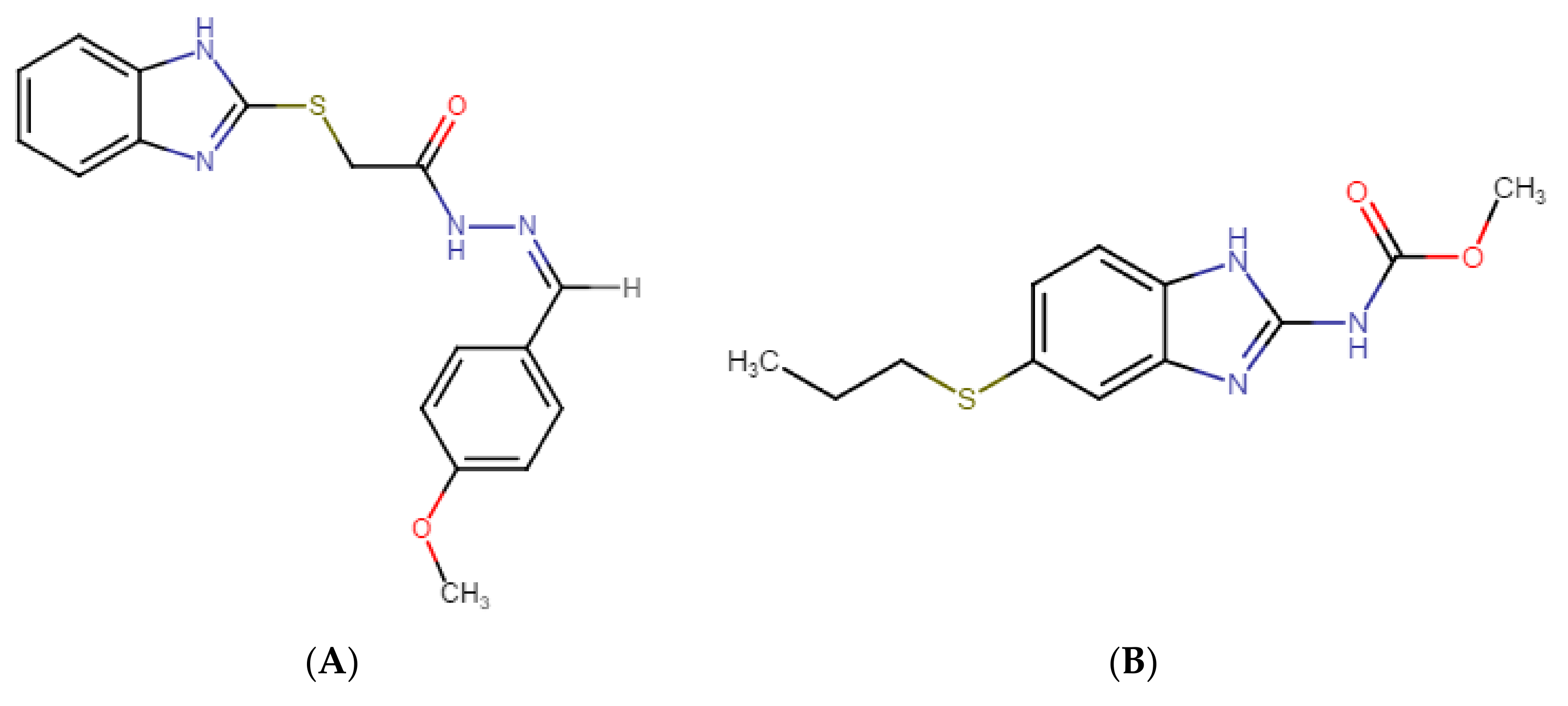
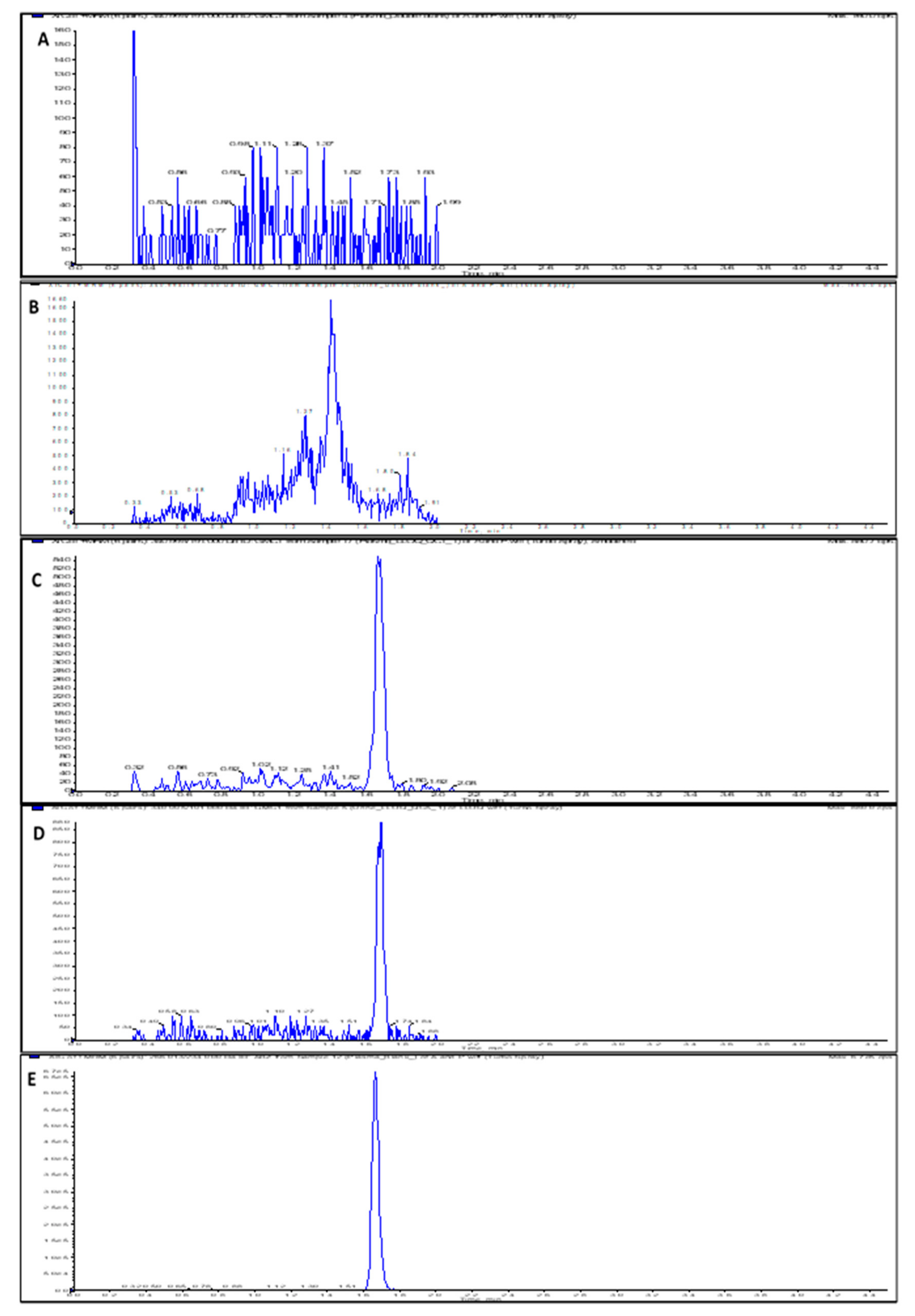
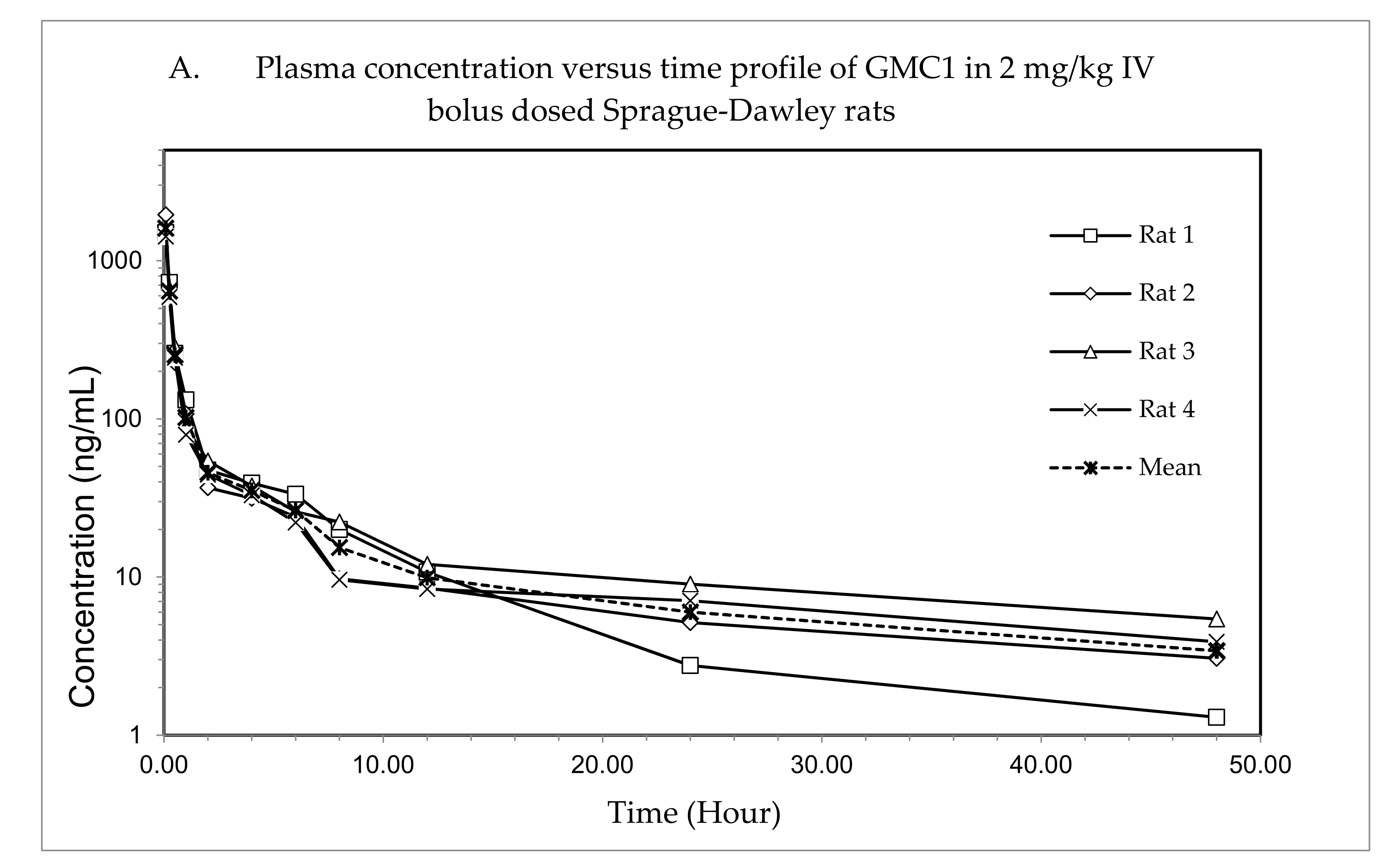
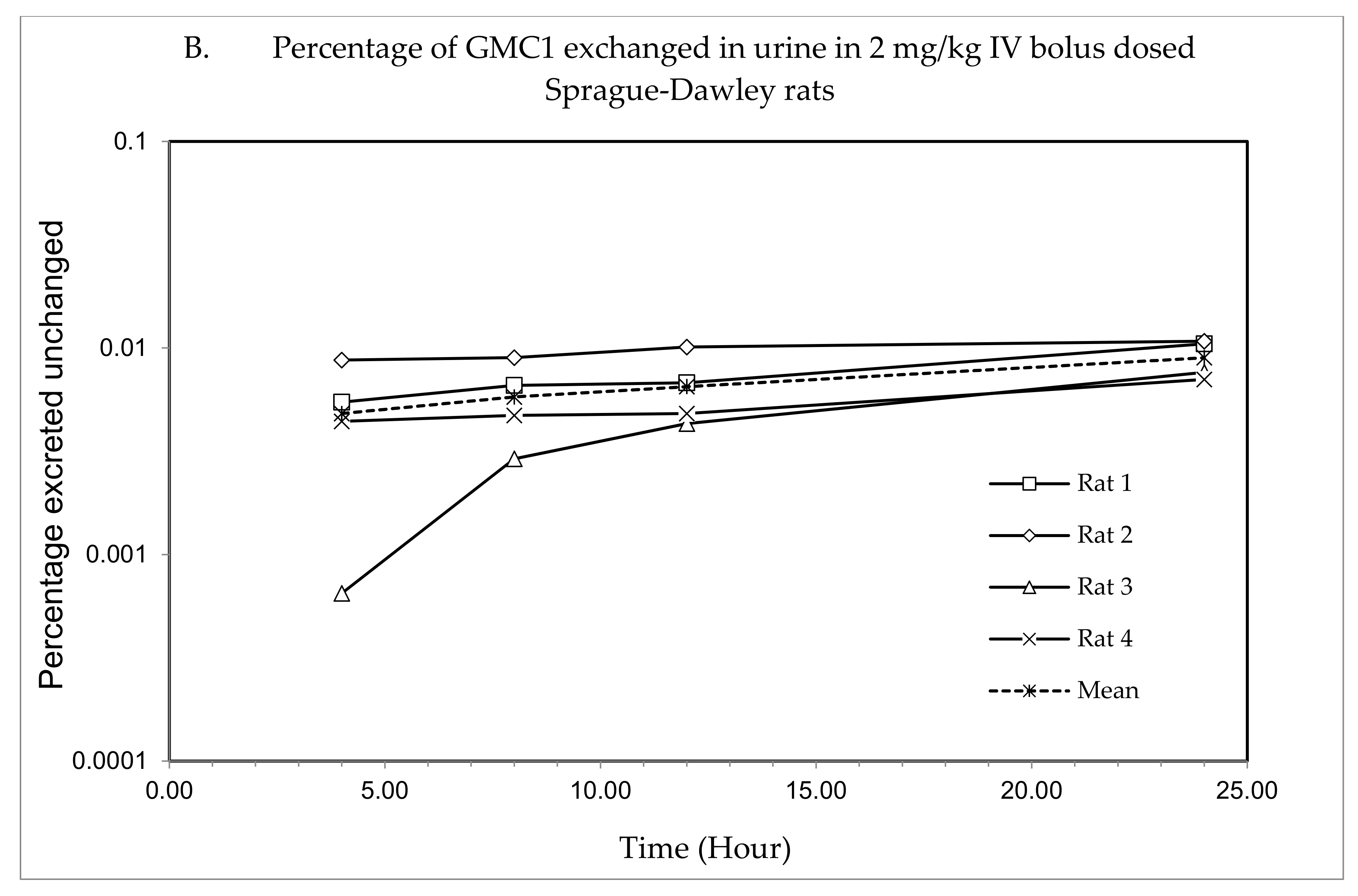
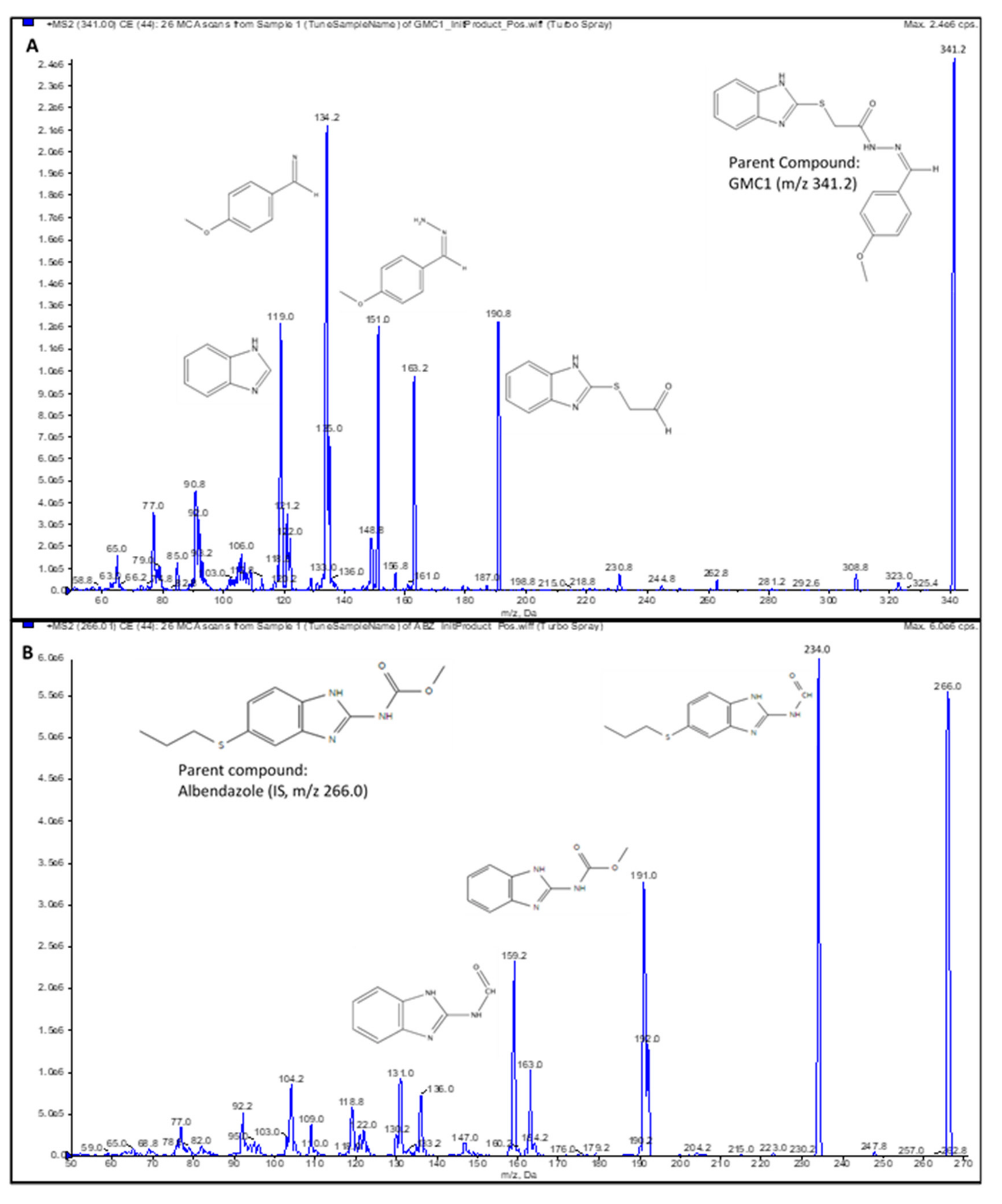
| Biological Matrix | QC | Nominal Concentration (ng/mL) | Intra-Day (n = 6) | Inter-Day (n = 6) | ||
|---|---|---|---|---|---|---|
| Accuracy (RE, %) | Precision (CV, %) | Accuracy (RE, %) | Precision (CV, %) | |||
| Plasma | LLOQ | 1 | 96 | 9.35 | 93.7 | 8.4 |
| LQC | 2.5 | 99.9 | 10.5 | 99.6 | 9.6 | |
| MQC | 400 | 90.2 | 7.1 | 92.8 | 2 | |
| HQC | 800 | 89 | 7.9 | 91.4 | 5.9 | |
| Urine | LLOQ | 1 | 104.2 | 9.9 | 94 | 11.1 |
| LQC | 2.5 | 101.1 | 7.6 | 93.2 | 8.4 | |
| MQC | 400 | 87.4 | 4.6 | 93.5 | 5.1 | |
| HQC | 800 | 88.6 | 7.5 | 92.2 | 5.5 | |
| Biological Matrix | Dilution Factor | Accuracy (RE, %) | Precision (CV, %) |
|---|---|---|---|
| Plasma | 5 | 104.9 | 6 |
| 10 | 106.9 | 3.3 | |
| 20 | 89.9 | 5.6 | |
| 50 | 98.5 | 9.6 | |
| Urine | 5 | 87.1 | 6.2 |
| 12.5 | 97.3 | 5.6 | |
| 25 | 102 | 3.4 | |
| 50 | 88.4 | 2.6 |
| Biological Matrix | QC | Nominal Concentration (ng/mL) | Extraction Recovery | Matrix Factor |
|---|---|---|---|---|
| Plasma | LLOQ | 1 | 98.8 ± 9.9 | 7.9 ± 3.3 |
| LQC | 2.5 | 95.0 ± 2.1 | 7.2 ± 2.9 | |
| MQC | 400 | 98.3 ± 7.4 | 9.7 ± 2.9 | |
| HQC | 800 | 99.6 ± 4.8 | 6.7 ± 3.6 | |
| Urine | LLOQ | 1 | 99.3 ± 4.4 | 5.1 ± 0.6 |
| LQC | 2.5 | 97.6 ± 4.6 | 2.6 ± 1.1 | |
| MQC | 400 | 99.6 ± 6.8 | 6.5 ± 3.8 | |
| HQC | 800 | 98.2 ± 5.6 | 5.1 ± 2.9 |
| Biological Matrix | Time | Mean Recovery ± SD (%) | ||
|---|---|---|---|---|
| Short-term/ Long-term Stability | Plasma | 2 h | 97.4 ± 8.9 | |
| 4 h | 88.9 ± 2.6 | |||
| 6 h | 80.1 ± 5.7 | |||
| 14 d | 101.2 ± 0.8 | |||
| Urine | 2 h | 94.2 ± 4.7 | ||
| 4 h | 93.9 ± 0.7 | |||
| 6 h | 93.7 ± 1.2 | |||
| 14 d | 97.0 ± 2.6 | |||
| Processed sample Or Auto-sampler stability | Time(h) | Mean Recovery ± SD (%) | ||
| No IS | With IS | |||
| Plasma | 2 | 94.7 ± 7.9 | 89.9 ± 4.7 | |
| 4 | 99.7 ± 4.6 | 97.5 ± 1.5 | ||
| 6 | 98.4 ± 6.2 | 96.2 ± 5.6 | ||
| Urine | 2 | 96.1 ± 2.4 | 96.4 ± 2.8 | |
| 4 | 89.7 ± 8.8 | 98.5 ± 1.1 | ||
| 6 | 95.2 ± 2.1 | 97.1 ± 4.8 | ||
| Freeze-thaw Cycle Stability | Quality Control Sample | Mean Recovery ± SD (%) | ||
| Plasma | LQC | 106.0 ± 5.9 | ||
| MQC | 98.5 ± 3.7 | |||
| HQC | 94.1 ± 2.9 | |||
| Urine | LQC | 113.0 ± 8.9 | ||
| MQC | 101.0 ± 3.9 | |||
| HQC | 86.6 ± 7.5 | |||
| Pharmacokinetic Parameter (Unit) | Mean ± SD (n = 4) |
|---|---|
| C0 (mg/L) | 2.5 ± 0.63 |
| AUC0−∞ (h*mg/L) | 1.2 ± 0.12 |
| T1/2 (h) | 14.8 ± 4.2 |
| VD (L/kg) | 36.9 ± 9.7 |
| Vss (L/kg) | 18.3 ± 6.7 |
| Cl (L/h/kg) | 1.7 ± 0.2 |
| MRT (h) | 10.7 ± 4.4 |
| Time (min) | Flow Rate (mL/min) | Mobile Phase A (%) | Mobile Phase B (%) |
|---|---|---|---|
| Initial | 0.5 | 90 | 10 |
| 0.40 | 0.5 | 90 | 10 |
| 0.45 | 0.5 | 65 | 35 |
| 2.50 | 0.5 | 5 | 95 |
| 3.50 | 0.5 | 5 | 95 |
| 3.55 | 0.5 | 90 | 10 |
| 4.50 | 0.5 | 90 | 10 |
| Parent | Transition (m/z) | Dwell Time (msec) | DP (Volts) | EP (Volts) | CE (Volts) | CXP (Volts) |
|---|---|---|---|---|---|---|
| GMC1 | 340.995 → 191.000 | 50 | 81.0 | 10.0 | 27.0 | 10.0 |
| Albendazole (IS) | 266.013 → 234.000 | 50 | 86.0 | 10.0 | 27.0 | 14.0 |
Publisher’s Note: MDPI stays neutral with regard to jurisdictional claims in published maps and institutional affiliations. |
© 2020 by the authors. Licensee MDPI, Basel, Switzerland. This article is an open access article distributed under the terms and conditions of the Creative Commons Attribution (CC BY) license (http://creativecommons.org/licenses/by/4.0/).
Share and Cite
Ekpenyong, O.; Cooper, C.; Ma, J.; Guy, N.C.; Payan, A.N.; Ban, F.; Cherkasov, A.; Cox, M.B.; Liang, D.; Xie, H. Bioanalytical Assay Development and Validation for the Pharmacokinetic Study of GMC1, a Novel FKBP52 Co-chaperone Inhibitor for Castration Resistant Prostate Cancer. Pharmaceuticals 2020, 13, 386. https://doi.org/10.3390/ph13110386
Ekpenyong O, Cooper C, Ma J, Guy NC, Payan AN, Ban F, Cherkasov A, Cox MB, Liang D, Xie H. Bioanalytical Assay Development and Validation for the Pharmacokinetic Study of GMC1, a Novel FKBP52 Co-chaperone Inhibitor for Castration Resistant Prostate Cancer. Pharmaceuticals. 2020; 13(11):386. https://doi.org/10.3390/ph13110386
Chicago/Turabian StyleEkpenyong, Oscar, Candace Cooper, Jing Ma, Naihsuan C. Guy, Ashley N. Payan, Fuqiang Ban, Artem Cherkasov, Marc B. Cox, Dong Liang, and Huan Xie. 2020. "Bioanalytical Assay Development and Validation for the Pharmacokinetic Study of GMC1, a Novel FKBP52 Co-chaperone Inhibitor for Castration Resistant Prostate Cancer" Pharmaceuticals 13, no. 11: 386. https://doi.org/10.3390/ph13110386
APA StyleEkpenyong, O., Cooper, C., Ma, J., Guy, N. C., Payan, A. N., Ban, F., Cherkasov, A., Cox, M. B., Liang, D., & Xie, H. (2020). Bioanalytical Assay Development and Validation for the Pharmacokinetic Study of GMC1, a Novel FKBP52 Co-chaperone Inhibitor for Castration Resistant Prostate Cancer. Pharmaceuticals, 13(11), 386. https://doi.org/10.3390/ph13110386







